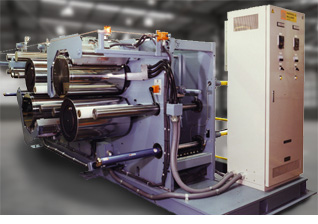

August 30 2018

When we’re discussing Machine Direction Orientation (MDO), we are describing machinery that heat and uniaxially stretch materials such as plastic film and sheet in the longitudinal (i.e. “machine”) direction over a series of rollers. The basic concept is relatively straight forward yet designing the right machine for the application is anything but simple. Over the next few articles I’m going to explain the key aspects of an MDO and how they relate to different applications. There are a lot of considerations that go into designing and building an MDO. I hope that you find these articles helpful in understanding the inner workings of these machines.
Let’s start at the molecular level. Orientation is defined as the straightening and alignment of polymer chains in plastic products like fiber, film, and sheet.The process of orienting plastics involves heating and stretching materials in a solid phase using specialized machinery to produce a less-random, more uniform arrangement of the polymer chains. The goal may be to increase material yield by down-gauging a film’s thickness while retaining or improving its physical properties. But, the process may also be used to attain a wide range of performance characteristics (mechanical, optical, shrink, barrier, porosity, etc.)that would not otherwise be possible.
So how exactly is this achieved? How do you down-gauge the film’s thickness while retaining or improving its properties?
An MDO can be used in line with a melt extrusion-casting process or offline as an independent roll-to-roll operation. In an MDO process, film is heated to the optimal stretching temperature via thermal conduction by direct contact with the surfaces of a series of heated rollers commonly referred to as pre-heat rollers. The optimal stretching temperature is typically just above the glass transition temperature or Vicat softening point of the material. Once the sheet has reached the proper temperature, it is subjected to a longitudinal stretching force imparted by a series of draw rollers running at increasing surface speeds. After the film is stretched, it may be annealed (stress relieved, heat set, etc.) in some fashion by maintaining or increasing the process temperature for some period of time, before its temperature is reduced via surface contact with a series of cooling rollers. An MDO is typically comprised of these three or four primary sections: preheating, stretching, annealing (optional), and cooling.
The first key aspect that you need to consider when thinking about an MDO is the heating medium you’re going to use in your application. There are four common types and I’ll quickly explain each one to give you a better idea of when it’s used.
Of course, the choice of heating method will be limited primarily by the process temperature requirements of the polymer(s) being oriented. Some may require high heat while others may require less to stretch the material to the right specifications, and in many applications, you may need a combination of heating elements to achieve the proper results.
In the next article I’ll discuss the different process conditions to consider in MDOs such as stretch ratios, stretch rates, line speed, and single-stage vs multistage stretching.